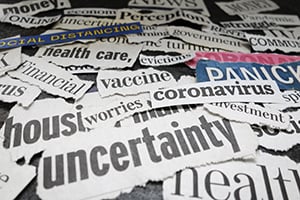 A lot has been written about how bad things are. Although vaccines are now being deployed, daily new cases continue to hit new highs. Even as testing expands, the positive rates remain way too high, signaling that the virus continues to spread. States that had the virus under control are now seeing new outbreaks.
A lot has been written about how bad things are. Although vaccines are now being deployed, daily new cases continue to hit new highs. Even as testing expands, the positive rates remain way too high, signaling that the virus continues to spread. States that had the virus under control are now seeing new outbreaks.
On the economic front, hiring has dropped substantially, layoffs are way up, and consumer confidence and spending have started to drop. Looking at the headlines, you would think we were headed into a combination of the 1918 flu pandemic and the Great Depression. Now, let’s add in the political chaos, with the pending inauguration (or not) of the new presidential administration, with half of the country dreading either outcome. And, of course, we are entering winter, with all of the darkness and depression it often entails.
It is not the best of times.
Markets Chase New Highs
Yet, for financial markets, it is the best of times, as they continue to chase new highs. Corporate earnings are substantially beating expectations. There is an apparent disconnect between the financial economy and the real economy. For many, that disconnect is one more thing to worry about. Surely this is just another Wall Street bubble, destined to collapse?
In fact, there is a simple explanation for the disconnect: while things are bad today, there are good reasons to believe that this is as bad as it gets—and that things are ready to start getting better. If you look forward, even a month or so, the news is likely to improve. In this sense, markets are not crazy, just looking beyond present conditions. This outlook is, if you think about it, exactly what they are supposed to do. But is there any reason to believe the markets are right here?
Positive Signs Showing in Medical News
Let’s start with the medical news. There is lots of bad news, but there are some positive signs, too. Daily case growth, for example, remains way too high. But in recent days, it has been growing more slowly. In fact, today we saw the seven-day average tick down for the first time since the post-Thanksgiving drop, which was caused by data distortions. This time, the slowing is likely to be real. We may turn the corner on the third wave in the next week or two.
As we do that, we now have one vaccine being deployed, and a second is likely to start next week. In the next month, we will see millions of the most at-risk Americans getting immunized. This process will take months to complete, but the effects on hospitalizations and deaths should show up much sooner. It will also change the narrative around the pandemic, from changing our lives forever to getting through the next couple of months. Rather than being mired in a never-ending swamp, we can now see the end. That perspective will help.
Economic Healing Continuing
On the economic front, hiring is down from earlier months. But it is still well above the levels we saw before the pandemic. Put another way, the healing continues, albeit at a slower rate. As the third wave gets under control and vaccines are more widely distributed, we can expect that healing to accelerate again, just as we saw after the prior waves. Faster job growth will help confidence (which has stayed much stronger than we saw at the start of the pandemic) and spending (taking it even further above what we saw before the pandemic). The economic fundamentals are much better than headlines suggest, and they could get even better given the likely medical improvements.
And that is even before we consider some of the possible positive surprises. First, if we get more federal stimulus, that would help the economy in the short term and set us up for an even stronger recovery next year. Second, consumers haven’t been spending and now have both lots of money saved and the desire to spend it as soon as they safely can. We could see a consumer spending boom next year. Third, millions of people have bought new houses, which is a vote of confidence in itself. Those houses will need furniture, curtains, and everything else, which is more consumer spending. Millions more have refinanced, which will put more money in their pockets to spend for the next decade. Once we get past the pandemic, there are quite a few tailwinds likely to show up.
Are Expectations Too Low?
Of course, we are not yet past the pandemic, or the political chaos of the election, or the pandemic recession. The risks are real, and they are dominating the headlines. For each of the major risks, though, we are at a turning point where we can see them getting better.
Normally, I highlight risks because most investors tend to look too much on the bright side. This is one of those times, though, that my job is to point out that rather than being too rosy, expectations are now too low. Things could get worse, in some ways, but in most they are likely to get better instead. Normally, I worry that things are as good as they get. Now, I believe they are as close to as bad as they can get—and will instead get better.
I am much happier being in this position. Winter is here—but spring is coming.


 Print
Print

